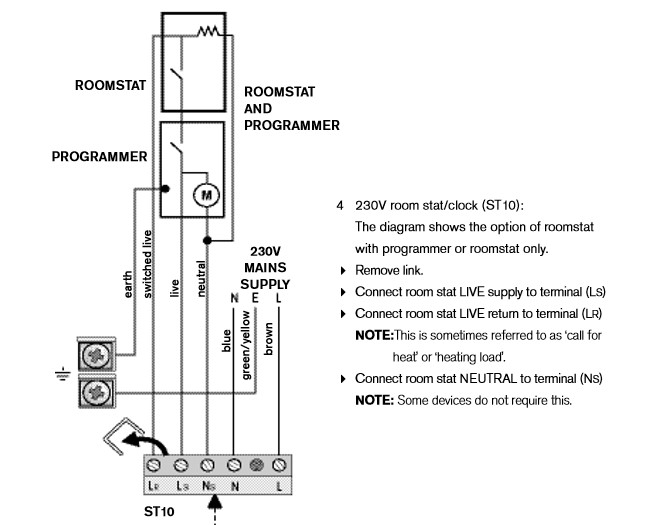Hi, I recently became a home owner and have been getting into my DIY. I have found a project where I want to be safe and make my first post in this wonderfully helpful community.
I'm looking to replace the existing Drayton LP711 with a Solus DT500RF on a Worcester Junior 28i Combi boiler.
I've sourced all the relevant diagrams, and taken a photo of the existing set up:
Boiler diagram:
Existing Drayton wiring:
Solus diagram:
So current Drayton wiring is:
N = Neutral (Blue)
L = Live (Brown)
1 = COM (Black)
2 = No wire (would be OFF)
3 = ON (Grey)
4 = No wire
The Solus wiring diagram is:
1 = NO - Normally Open [N/O]
2 = COM - Linked Live feed (230V AC heating applications only)
3 = L - Live feed (230V AC)
4 = N - Neutral
Seems straight forward I just wire the existing L (live) and N (neutral) to 3 (live) and 4 (neutral) on the Solus.
Also 1 (COM) is 2 (COM) on the Solus. Does that mean I can just wire 3 (ON) on the Drayton to 1 (Normally Open) on the Solus? Is Normally Open N/O the same as ON?
Thanks in advance for any help! I'm keen to avoid frying any electrics by getting it wrong.
I'm looking to replace the existing Drayton LP711 with a Solus DT500RF on a Worcester Junior 28i Combi boiler.
I've sourced all the relevant diagrams, and taken a photo of the existing set up:
Boiler diagram:
Existing Drayton wiring:
Solus diagram:
So current Drayton wiring is:
N = Neutral (Blue)
L = Live (Brown)
1 = COM (Black)
2 = No wire (would be OFF)
3 = ON (Grey)
4 = No wire
The Solus wiring diagram is:
1 = NO - Normally Open [N/O]
2 = COM - Linked Live feed (230V AC heating applications only)
3 = L - Live feed (230V AC)
4 = N - Neutral
Seems straight forward I just wire the existing L (live) and N (neutral) to 3 (live) and 4 (neutral) on the Solus.
Also 1 (COM) is 2 (COM) on the Solus. Does that mean I can just wire 3 (ON) on the Drayton to 1 (Normally Open) on the Solus? Is Normally Open N/O the same as ON?
Thanks in advance for any help! I'm keen to avoid frying any electrics by getting it wrong.




